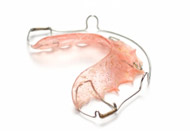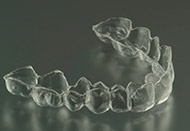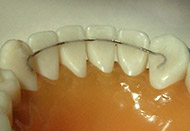When we remove your braces, we will begin the “retainer stage” of your treatment. After the treatment is completed, you will be given retainers for both the upper and lower set of teeth. Your final long-term orthodontic result depends on your retainer wear, so please follow through with the retainer protocol to ensure straight teeth for the long-term!! The retention phase lasts forever! Why? Orthodontically straightened teeth are “artificially straightened teeth”; Mother Nature did not place them there. We had to gently force and guide the teeth to go into positions Mother Nature did not naturally place them. If we do not hold the teeth with a retainer, they will very likely move and shift over time. The teeth can shift whether or not you have had your wisdom teeth removed. Moreover, it does not matter how old one is or how long ago the braces were removed. This is because a person’s teeth can slowly shift over time via the normal aging process. Thus, retainer wear is very important! Retainer wear is a long term body maintenance issue; it is no different than routinely taking a shower, doing your hair, brushing your teeth, etc. If you want to keep your teeth straight, proper and frequent retainer wear is the only way!
Removable Retainers
Hawley Retainers
The Hawley retainer, one of the most common types, is a removable retainer made of a combination of metal wires and sturdy acrylic, and is designed to keep your teeth in place. This retainer is specially made from impressions of your teeth so that it fits snugly and comfortably in the roof of your mouth, while any wire or acrylic framing keeps your teeth in perfect position. They can be taken out for eating, sports, and special events. The acrylic can also be personalized with a large number of colors and/or patterns, and can last many years, unlike Essix-style removable retainers. The main disadvantages of a removable retainer are that kids can lose them if they are not careful — and you have to remember to wear them!
Essix Retainers
The Essix retainer is a clear removable retainer that fits over the entire arch of teeth. Essix retainers have no metal wires and are virtually invisible. They are very durable, inexpensive and easy to wear. Both Hawley and Essix retainers work well, but the clear plastic of Essix retainers tends to wear out more quickly and usually last only 1 to 2 years before a replacement is needed.
Basic Instructions and Care
Wear the retainers day and night for the first 4-6 months after the braces are removed. Take out for eating, brushing, sports, and for special events. Clean the retainer daily with soap, water, and an old toothbrush. Do not attempt to boil the retainer or place in the dishwasher as this can deform the retainer. You can place the retainer in a cup with ½ warm water and ½ white vinegar and soak for one hour to loosen up any hard deposits that may form. You will be given a hard plastic case for the retainer. Place your name and phone number on the case and always place the retainer in the case while not in use. If the retainer is placed in a pocket or book bag without the case, it can be damaged! While eating, take the retainer out but do not place in a napkin; you can forget it and throw it away! Dumpster diving is no fun! It is recommended kids do not take the retainer into the school’s lunchroom. Instruct kids to leave the retainer in its case in their locker, book bag, or homeroom. After the first 4-6 months, one can switch to nighttime wear of the retainer while sleeping. This should be carried out for the next 12 months or so roughly every night. At 18 months, one can switch to nighttime wear roughly 4-5 nights per week and this should be carried out indefinitely! This is the only way to guarantee the teeth stay straight forever! Finally, make sure to keep the retainers away from your dog. They LOVE to chew on them and even bury them!
Fixed (Bonded) Retainers
Another common retainer design is the “glued-in” wire type, known as a fixed — or bonded — retainer. This type is commonly glued to the backsides of the lower 6 front teeth (3 teeth left of center and 3 right of center). A glued-in retainer does not touch or hold the back teeth because is not possible to have a wire go around the entire mouth. Thus, the back teeth may possibly move over time.
The primary advantage of a glued-in retainer is: it’s glued in! Patients don’t have to remember to wear it and can’t lose them like removable retainers. Some disadvantages are: one has to brush and floss around it like braces and it can be a food/plaque/tartar trap; if one eats hard or crunchy foods the retainer wire can be deformed, broken into pieces, or can become un-glued, necessitating repairs. If the glued-in retainer wire is deformed or bent, the teeth physically attached to it can be forced to unfavorably move by the bent wire. This may necessitate the need to remove the retainer wire and to orthodontically re-treat the affected teeth in order to re-align them. A glued-in retainer is possible on the upper front teeth only in certain patients. In certain patients the lower front teeth will bite into the upper glued-in retainer which is not recommended. Dr. Johnson can tell you if you are a candidate for an upper glued-in retainer.
Basic Instructions and Care
Gently clean and floss around the glued-in retainer daily. Rough brushing or flossing around the retainer can cause it to become un-glued. Moreover, refrain from hard and crunchy foods in the area of the retainer, as this will break or bend the retainer!